|
Magic Realism has emerged as one of the more intriguing art terms
over the past few decades. Often misunderstood and seldom embraced
by critics and artists without reservations, Magic Realism occupies an important niche in
art history, one which warrants more scholarly investigation and
rigorous elucidation. A thorough survey of German art during the
Weimar era, along with fresh assessments of the impact of Naive art, Metaphysical
art and Surrealism on European and American
artists during the four decades that followed World War I, are important
exercises in developing a full understanding of Magic Realism. Also
it is important to recognize that both style and
content together create the "magic" in a Magic Realism
painting, especially in works by the American Magic Realists of the
1940s and 50s.
Many discussions about Magic Realism begin with historical
references to the German writer Dr. Franz Roh and cite German art
during the years of the Weimar Republic as the source of this type
of art. However, Weimar art was diverse and an extensive review of
this period is needed to appreciate the complex dynamics that
influenced German artists during the years following World War I.
Many artists in fact transitioned between styles, adapting their
approach as the social, political and economic environments changed.
Traits of Magic Realism can be identified in many works of art
painted in Germany during this era, but it is difficult to establish
that a cohesive movement evolved. It is more accurate to describe
Weimar art as a melting pot of styles which produced a broad range
of Magic Realism paintings and which in turn was connected to a
broader movement outside Germany.
| This article has
been registered with the United States Copyright Office. |
Franz Roh coined the term Magic Realism in
Nach-expressionsmus, magisher Realismus, Probleme der neuesten
europaischer Malerei
1a, published in 1925. In his book Roh
carefully detailed the stylistic
characteristics of a new
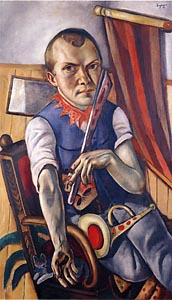 art
movement which he called Post-Expressionism, and contrasted them
with Expressionism. He gave this new type of art the byname Magic
Realism, in order to suggest what he considered its special
evocative qualities.
In June 1925, Gustav Hartlaub opened an exhibition Die Neue
Sachlichkeit in Mannheim.
Roh and Hartlaub seemed to
focus on similar art when first commenting on Post-Expressionism,
art which was moving away from abstraction and emotionally charged
imagery. Hartlaub initially emphasized that he saw a division of two
separate wings within this type of art, a classically oriented right
wing and a socially critical left one
1b. Roh helped him to organize
the exhibition, but he avoided supporting Hartlaub's bipolar
outlook. Roh felt instead that there was a singular movement away
from Expressionism, which had many manifestations and which was also
evident in other European countries. art
movement which he called Post-Expressionism, and contrasted them
with Expressionism. He gave this new type of art the byname Magic
Realism, in order to suggest what he considered its special
evocative qualities.
In June 1925, Gustav Hartlaub opened an exhibition Die Neue
Sachlichkeit in Mannheim.
Roh and Hartlaub seemed to
focus on similar art when first commenting on Post-Expressionism,
art which was moving away from abstraction and emotionally charged
imagery. Hartlaub initially emphasized that he saw a division of two
separate wings within this type of art, a classically oriented right
wing and a socially critical left one
1b. Roh helped him to organize
the exhibition, but he avoided supporting Hartlaub's bipolar
outlook. Roh felt instead that there was a singular movement away
from Expressionism, which had many manifestations and which was also
evident in other European countries.
Hartlaub first tried to
organize his exhibition in 1923, however hyperinflation made that
impossible. He finally succeeded in 1925. In the catalog he
emphasized that the exhibition was not opposed to Expressionism, but
that it was presenting a new type of art that was emerging in
Germany. Artworks by Verist (socially critical) artists like Otto
Dix and George Grosz were included, but Hartlaub took great pains
not to include controversial or provocative works, hoping to avoid any
negative repercussions. The exhibition received strong support from
the press and it made a profound impression on the public.
Neue Sachlichkeit (New Objectivity) became a
label applied by many writers when referring to the typical
representational styles that developed during Weimar period. Within
a short time after the exhibition many German artists adopted a
cool, detached, matter-of-fact style, which was particularly evident in portraits.
This
style became palatable to bourgeois tastes, and the
last vestiges of Expressionism were shed. Unfortunately, the National
Socialists took control of Germany in 1933, and the Weimar era
ended. The Nazis installed an official state approved style, das
Blut und Boden (Blood and Soil). Within a few years many works by
the prominent artists of Neue Sachlichkeit were branded as
Degenerate Art. Many paintings were confiscated; some were publically burned. Post-Expressionism by any name came to an
end. Roh's term Magic Realism was never widely used in Germany during the
Weimar era, but his concepts were well known in artistic circles and
spread within Europe and eventually to the Americas.
A review of Hautlaub's Die Neue Sachlichkeit exhibition catalog
reveals that almost half of paintings presented were produced by
either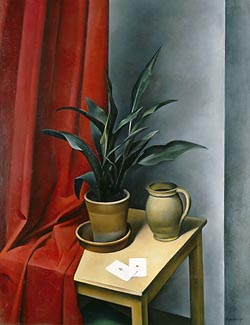 Max Beckmann or by painters associated
with Munich (Schrimpf,
Kanoldt, Mense,
Erbsloeh,
Schulz-Matan and
Daveringhausen). Franz Roh lived
near Munich and followed developments there closely. Many historians
subsequently identified the Munich artists as central to Roh's Magic
Realism. Most of these artists dispersed by 1926, and Munich lost
its role as the most important center of Post-Expressionism. With
regard to Max Beckmann, Hartlaub considered him to be the leader of the
new movement. However, by 1925 Beckmann had shifted away from his
Magic Realist phase, and moved toward a more individualistic style,
one ultimately integrated diverse influences, including
Cezanne, Grünewald,
Brueghel and medieval stained glass.
Max Beckmann or by painters associated
with Munich (Schrimpf,
Kanoldt, Mense,
Erbsloeh,
Schulz-Matan and
Daveringhausen). Franz Roh lived
near Munich and followed developments there closely. Many historians
subsequently identified the Munich artists as central to Roh's Magic
Realism. Most of these artists dispersed by 1926, and Munich lost
its role as the most important center of Post-Expressionism. With
regard to Max Beckmann, Hartlaub considered him to be the leader of the
new movement. However, by 1925 Beckmann had shifted away from his
Magic Realist phase, and moved toward a more individualistic style,
one ultimately integrated diverse influences, including
Cezanne, Grünewald,
Brueghel and medieval stained glass.
Franz Roh stated that Magic Realism should not simply bring back
"the more neutral art of Courbet and Leibl"
1c. He opposed any revival
of 19th Century academic art, feeling that artists should avoid
regression.
Kanoldt,
Schrimpf and Mense of
the
Munich group all had connections
with Italian art through various
Deutsch-Römer
19th Century artists, but they were also heavily influenced by a
number of
Italian contemporary artists, particularly
Carlo Carra and
Giorgio de Chirico. A number of important German
artists outside Munich were influenced by de Chirico's art,
including Anton Raederschidt, George Grosz,
Rudolf Dischinger,
Felix Nussbaum and Max Ernst. The
paintings of
Henri Rousseau, the French primitivist, had an even
broader influence on Weimar art.
Naive nuances are often apparent in the works of many
German artists, including those by Max
Beckmann, Carl Grossberg,
Georg Scholz,
Wilhelm Schnarrenberger,
Ernst Thoms,
Niklaus Stoeklin,
Grethe Jüergens,
Erich Wegner,
Walter Spies,
Niklaus Stoeklin, Gyorgy Stefula and
Adolf Dietrich.
In his 1957 book, L'Art magique, Andre Breton wrote "with
Rousseau we can for the first time talk about Magic Realism"
1d.
The postwar period saw the spread of a counter-Modernist
movement in the arts, known as the Return to Order (or Call to O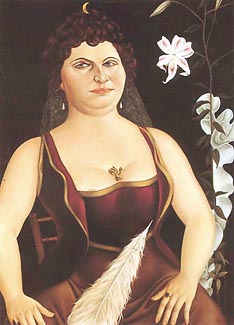 rder),
which included the revival of many traditional painting techniques.
In Italy Il
Novecento Italiano in
particular stood out in this regard, through the paintings of
Felice Casorati,
Achille Funi, Ubaldo Oppi,
Gino Severini and
Antonio Donghi., as did works by
Andre Derain,
Felix Vallotton and
Auguste Herbin in France.
Around 1925 a strong tendency toward precision and
illusionism emerged within German art. This was partially due to
the success of Hautlaub's exhibition but the trend was also
supported by a steady influx of new artists. Many artists
became interested in the art of the early Renaissance and adopted techniques
based on their careful studies of the Flemish and German Masters. By
the mid 1920s numerous intensely detailed paintings began to appear,
sometimes exhibiting an almost unnatural realism. Often the "magic"
of these paintings was embedded in the details of the work, by
juxtaposition or isolation of objects, or by an unusual perspective.
Important variations of Magic Realism developed from this tendency.
The paintings of
Franz Radziwill are good examples, as he often instilled an
eerie atmosphere into his works by an unusual color palette.
Equally notable were
architectonic paintings of Carl Grossberg,
who sometimes added uncanny elements to his works such as bats,
birds or apes. The portraits of Otto Dix manifested a versatility in
capturing "types" of German people of the 1920s. Meanwhile
Christian Schad studied Raphael and other Italian Masters while
living in Naples during the early 1920s. Schad's paintings consistently exhibited a cool
and almost photographic sharpness, but he often included both naive
and metaphorical elements. His paintings
are often cited by art historians as the quintessential art of Neue
Sachlichkeit. Many of Schad's paintings also exhibit unusual and
intangible qualities connecting him to Magic Realism, particularly
during his stays in Naples and Vienna, and after World War II. rder),
which included the revival of many traditional painting techniques.
In Italy Il
Novecento Italiano in
particular stood out in this regard, through the paintings of
Felice Casorati,
Achille Funi, Ubaldo Oppi,
Gino Severini and
Antonio Donghi., as did works by
Andre Derain,
Felix Vallotton and
Auguste Herbin in France.
Around 1925 a strong tendency toward precision and
illusionism emerged within German art. This was partially due to
the success of Hautlaub's exhibition but the trend was also
supported by a steady influx of new artists. Many artists
became interested in the art of the early Renaissance and adopted techniques
based on their careful studies of the Flemish and German Masters. By
the mid 1920s numerous intensely detailed paintings began to appear,
sometimes exhibiting an almost unnatural realism. Often the "magic"
of these paintings was embedded in the details of the work, by
juxtaposition or isolation of objects, or by an unusual perspective.
Important variations of Magic Realism developed from this tendency.
The paintings of
Franz Radziwill are good examples, as he often instilled an
eerie atmosphere into his works by an unusual color palette.
Equally notable were
architectonic paintings of Carl Grossberg,
who sometimes added uncanny elements to his works such as bats,
birds or apes. The portraits of Otto Dix manifested a versatility in
capturing "types" of German people of the 1920s. Meanwhile
Christian Schad studied Raphael and other Italian Masters while
living in Naples during the early 1920s. Schad's paintings consistently exhibited a cool
and almost photographic sharpness, but he often included both naive
and metaphorical elements. His paintings
are often cited by art historians as the quintessential art of Neue
Sachlichkeit. Many of Schad's paintings also exhibit unusual and
intangible qualities connecting him to Magic Realism, particularly
during his stays in Naples and Vienna, and after World War II.
An important characteristic of Magic Realism is ultrasharp
focus. Sharp detail is seen throughout many painting, including in
the background. Highly defined and even exaggerated detail may also
appear selectively in areas that the artist wishes to accentuate.
The overall effect is to move the viewer's attention all over the
painting,
,%201928%201b.jpg) before the totality of the composition can be comprehended. This
same effect frequently occurs in naive paintings
and also occurred in many works by the German and Flemish
Renaissance Masters. Another characteristic often seen in Magic
Realism paintings is an almost unnatural clarity. In many cases this
stemmed from a flattened tonality and/or idealized lighting, or from
suppression and/or selective use of shadows. As a result of these
factors, many Magic Realism paintings exhibit a false naturalism. before the totality of the composition can be comprehended. This
same effect frequently occurs in naive paintings
and also occurred in many works by the German and Flemish
Renaissance Masters. Another characteristic often seen in Magic
Realism paintings is an almost unnatural clarity. In many cases this
stemmed from a flattened tonality and/or idealized lighting, or from
suppression and/or selective use of shadows. As a result of these
factors, many Magic Realism paintings exhibit a false naturalism.
A focus on objects helped to define the works of German artists
during the Weimar years. Franz Roh stated that Magic Realism
"employs various techniques that endow all things with a deeper
meaning and reveal mysteries that always threaten the secure
tranquility of simple and ingenious things... it is a question
of representing before our eyes, in an intuitive way, the fact, the
interior figure, of the exterior world"
1e.
He spoke of a "gegenstandlichkeit', or a sensitivity to objects.
Many of Roh's comments about Magic Realism stem from his
interest in phenomenology, a philosophical methodology which
studies structures within our consciousness. Roh
commented further about the emergence of Magic Realism "the autonomy of the
objective world around us was once more enjoyed; the wonder of
matter that could crystallize into objects was to be seen anew"
1f.
These comments echo those by De Chirico who wrote
"Every object has two aspects: the common aspect, which is the one
we generally see and which is seen by everyone, and the ghostly
metaphysical aspect which only rare individuals see at moments of
clairvoyance and metaphysical meditation. A work of art must relate
something that does not appear in its visible form"
1g.
In his 1925
book Franz Roh enumerated the stylistic characteristics of Magic
Realist paintings as compared to Expressionism. He envisioned Magic
Realism as a broad movement, one which was also evident outside of
Germany. Roh identified seven sources for Magic Realism. Each of
these sources initiated a distinctive type of art. The multifaceted
origins of Magic Realism have been overlooked by many writers and
critics, many of whom promoted narrowed definitions of the art term.
However, most of these variants fit under Roh's broad umbrella of
Magic Realism.
Roh emphasized that Magic Realism should not bring
back the Naturalism which was prevalent in the last decades of
the 19th Century. Rather than depending on mere mimesis, Roh said that the
new art should always originate in the artist's imagination. In many
cases Magic Realism results from a synthesis, often from the
combined influences of more than one of these types of art. Roh's
sources for Magic Realism
1h were as follow:
-
Neoclassical - roughly Hartlaub's right wing. More apparent in Italian
art, especially Il Novocento Italiano.
-
Socially Critical - the so-called Verism of Grosz, Dix, Schlicter
and others.
-
Metaphysical - art influenced by Metaphysical paintings.
-
Naive - art influenced by Henri Rousseau or by neo-primitivism (Carra).
-
Hardened Expressionism - Beckmann, Carl Hofer, Albert Birkle and
others.
-
Constructivists artists in Germany and France, including Oskar
Schlemmer and the French Purists.
-
Colorists working with a new type of tonal painting, including
Hermann Huber.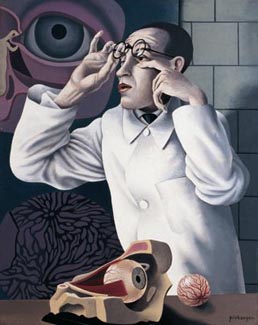
The first five groupings proved to be the most important. This overall diversity was not without precedent
in major art
movements. For example, Post-Impressionism refers to broad
divergences from Impressionism in the 1880s and 90s. Both Symbolism and
Surrealism were complex movements, notable for considerable variations in origin,
style and content. The initial multiformity of Magic Realism as seen
in the early 1920s narrowed over time. Several variations evolved
and coalesced into national types, mainly in Italy, the Netherlands
and in the Americas.
The Surrealist movement developed in the 1920s mainly along two
important paths. Initially it was driven by writers in their works
of automatism, arising from the exploration of the subconscious and
free association. In the late 1920s and 1930s veristic surrealism
developed in the visual arts, initially sharing some traits of Magic
Realism. In many early works from the 1920s, particularly
those of Salvador Dali and Rene Magritte, the
characteristics of Magic Realism were quite evident. However by the early 1930s veristic Surrealism
increasingly incorporated fantastic imagery, biomorphism and
irrational elements which distanced it
from Magic Realism.
German artists developed a fascination with a newly found world of
objects during the Weimar period, fueled by
a technological revolution and the emergence of a mass culture. At
the same time, the political and economic instability during the
interwar period fomented alienation of the individual and caused
intense cultural
anxieties. The manifestations of these insecurities was evident in
the
use by artists of visual devices, some of which Giorgio de Chirico referred to as defamiliarization, or making the ordinary seem strange.
Thus came about the development of "The Uncanny", an aesthetic which
became as important to Magic Realism as the sublime had been for
Romanticism in the previous century. The Uncanny was often seen in
representational art produced between 1920 and 1960
1i. It can arise
simply from the isolation of objects within a painting. From the mid
1930s on
it became an important, if not an essential, component of Magic Realism,
although in some cases its presence appears to be subtle, or at least not
readily obvious.
In the late 1920s Magic Realism developed in other European
countries and in the Americas. This was also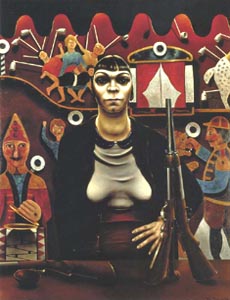 a time in which Surrealism began to build up steam as an art
movement, and it was to soon overshadow Magic Realism. Andre Breton, as
the foremost organizer of Surrealism, actively recruited both in
Europe and North America. His efforts did not always bear fruit. As
Fridha Kahlo bluntly put it, "I don't paint dreams or
nightmares. I paint my own reality"
1j. In France and Belgium, artists
like Pierre Roy and
Paul Delvaux, both admirers of Giorgio de Chirico, produced
works that bordered on an improbable reality. Important Magic
Realist active during the 1930s included
Balthus in France,
Cagnaccio di San Pietro and Gregorio
Sciltian in Italy,
Edward Wadsworth and
Tristram Hillier in England, as well as
Antonio Berni in Argentina. During the same
period, Dutch artists Carel Willink,
Raoul Hynckes,
Dick Ket, Wim
Schumacker and Pyke Koch
worked in an imaginative type of Realism to establish a strong tradition
of Dutch Magic Realism, one which lives on to our present day. Pyke Koch
provided a concise definition of the mission of the Magic Realist,
"Magic Realism is based on the representation of what is possible,
but not probable"
1k.
a time in which Surrealism began to build up steam as an art
movement, and it was to soon overshadow Magic Realism. Andre Breton, as
the foremost organizer of Surrealism, actively recruited both in
Europe and North America. His efforts did not always bear fruit. As
Fridha Kahlo bluntly put it, "I don't paint dreams or
nightmares. I paint my own reality"
1j. In France and Belgium, artists
like Pierre Roy and
Paul Delvaux, both admirers of Giorgio de Chirico, produced
works that bordered on an improbable reality. Important Magic
Realist active during the 1930s included
Balthus in France,
Cagnaccio di San Pietro and Gregorio
Sciltian in Italy,
Edward Wadsworth and
Tristram Hillier in England, as well as
Antonio Berni in Argentina. During the same
period, Dutch artists Carel Willink,
Raoul Hynckes,
Dick Ket, Wim
Schumacker and Pyke Koch
worked in an imaginative type of Realism to establish a strong tradition
of Dutch Magic Realism, one which lives on to our present day. Pyke Koch
provided a concise definition of the mission of the Magic Realist,
"Magic Realism is based on the representation of what is possible,
but not probable"
1k.
In the 1920s an important development in American art occurred,
which was at first referred to as Cubist Realism, then as the
Immaculate School and eventually as Precisionism. The movement
encompassed a range of styles, from abstraction to an early type of
photorealism, and covered architectural and industrial subject
matter along with the vernacular and provincial. The most prominent
of the Precisionists was Charles Sheeler, who developed a realistic
style in the late 1920s, reminiscent of Neue Sachlichkiet.
Sheeler and several other painters associated with Precisionism were also
among the first Americans to produce Magic Realism.
In the 1920s American artist Grant Wood made
several study trips to Europe. He came away most impressed with the
precision and clarity that he saw in the works of the old Flemish
masters, especially those of Jan van Eyck and Hans Memling. He also
saw firsthand the developments occurring in German
%201930%201b.jpg) contemporary art. Two distinct types of Magic Realism appear in his
work produced after 1930. First his portraits are done in the style
of the Flemish and German masters and include both obvious and
subtle symbolism.
In his landscapes, he often makes use of naive
stylizations and miniaturization.
Though Grant Wood is generally considered to be one of the three
major Regionalist painters, many of his
paintings are wonderful examples of Magic Realism.
contemporary art. Two distinct types of Magic Realism appear in his
work produced after 1930. First his portraits are done in the style
of the Flemish and German masters and include both obvious and
subtle symbolism.
In his landscapes, he often makes use of naive
stylizations and miniaturization.
Though Grant Wood is generally considered to be one of the three
major Regionalist painters, many of his
paintings are wonderful examples of Magic Realism.
During
the 1930s the Great Depression had a signification impact on
American artists. Many struggled to make a living and sought
government support in the WPA Federal Art Project. An indigenous
type of academic art developed in the United States during the
1930s, which is referred to as The American Scene. The subject
matter chosen by many artists during this period was often anecdotal, either involving some aspect of social commentary (Social
Realism) or portraying the regional characteristics of American rural
culture (Regionalism). A wide range of styles developed during this
period, from academic naturalism to naive stylization, and including
an indigenous expressionism. Meanwhile Surrealism was formally
introduced in the U.S. in late 1931 at an exhibition titled "Newer
Super Realism" at the Wadsworth Athenuem in Hartford, CT. Included
were works by De Chirico, Salvador Dali, Max Ernst and Pierre Roy. A
new variation of American art was spawned during the 1930s, called
Social Surrealism, which was a blend of Surrealism with Social
Realism. Paintings by James Guy and Walter Quirt were typical.
Generally American painters were less interested in psychoanalytical
introspection and probing of the subconscious than their European
counterparts, and their interactions with Surrealism were defined by
an American iconography and outlook. In the 1930s many artists
produced works that incorporated fanciful elements, but they did so
within the context of a basically realist framework.
Strange, mysterious or
uncanny elements were often embedded in many paintings, and
narratives were often ambiguous or partially hidden. A new type of American art evolved,
Realism
with overtones of Surrealism. This art became known as
Magic Realism. The painters of the 1930s often cited as producing this
type of art included
Ivan Albright,
Peter Blume,
Ben Shahn, O Louis
Guglielmi and
Philip Evergood.
The late 1930s saw an emigration of European artists to
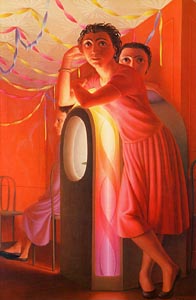 the Americas, including many connected with the Surrealism movement.
These artists were not always well received by their American
counterparts, and lived mostly in isolation. Most of the Surrealists
settled in New York City, yet when Breton arrived in 1941 he was
unable to remobilize the formal movement. Regardless of cultural
barriers and the fact that it failed to flourish as an American
movement, Surrealism had a rather significant impact on American art
during the 1930's and 40s, providing liberation from conventionalism
and the prevailing attitudes that had previously favored Regionalism.
Surrealism also had a significant influence in the development of Abstract
Expressionism.
the Americas, including many connected with the Surrealism movement.
These artists were not always well received by their American
counterparts, and lived mostly in isolation. Most of the Surrealists
settled in New York City, yet when Breton arrived in 1941 he was
unable to remobilize the formal movement. Regardless of cultural
barriers and the fact that it failed to flourish as an American
movement, Surrealism had a rather significant impact on American art
during the 1930's and 40s, providing liberation from conventionalism
and the prevailing attitudes that had previously favored Regionalism.
Surrealism also had a significant influence in the development of Abstract
Expressionism.
In 1943 an exhibition entitled "American Realists and Magic
Realists"
1l was assembled at the Museum of Modern Art in New York by
Dorothy C. Miller. Many young artists who would help develop Magic
Realism into a mature movement were represented in this exhibition,
including
Jared French,
Paul Cadmus,
Charles Rain and
Andrew Wyeth. Within a few years
George Tooker,
Henry Koerner, Robert Vickery,
John Wilde and Canadian
Alex Colville began to produce paintings
which we now identify with Magic Realism. All of these artists used
Tempera techniques, which dated back to the Early Renaissance. Their
paintings were carefully crafted objects of art, with imagery that was
infused with metaphoric and symbolic elements. Some of the paintings
by these artists featured "surreal" or dream-like nuances. Yet
none of the American Magic Realists were directly connected with the
Surrealist movement. In many ways the developments of Magic Realism
in the 1940s bypassed and surpassed Surrealism in the Americas.
During the 1950s many of the artists associated
with Magic Realism exhibited at the
Edwin Hewitt Gallery in New York City, and the movement had a
significant following..
Although sharing some common ground, the approach of the Magic
Realist differed greatly from that of the Surrealist. In contrast to
methods that encouraged the spontaneity and irrationality of
Surrealism, the Magic Realists carefully planned and meticulously
executed intricate compositions. George Tooker once stated "It is the
novelty and shock value of the surrealists that disturbs me. I am
after painting reality impressed on the mind so hard that it recurs
as a dream; but I am not after painting dreams as such, or fantasy"
1m.
In the late 1940s and early 50s Magic Realism flourished,
distinguishing itself from other movements such as Social Realism
and
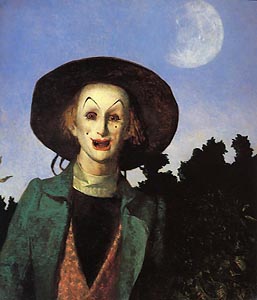 Surrealism.
During this period Magic Realism also helped to carry the banner of
Realism, during the heyday of the Abstract Expressionist movement. The art
establishment of the day marginalized representational art.
Only in the late 1960s did the pendulum of tastes began to swing
away from abstract styles. However Photorealism and Hyperrealism,
with a more detached approach to content, became the preferred
approach for a new generation of artists. Fortunately American Magic
Realists have not been forgotten and finally received some overdue recognition in recent
years. Surrealism.
During this period Magic Realism also helped to carry the banner of
Realism, during the heyday of the Abstract Expressionist movement. The art
establishment of the day marginalized representational art.
Only in the late 1960s did the pendulum of tastes began to swing
away from abstract styles. However Photorealism and Hyperrealism,
with a more detached approach to content, became the preferred
approach for a new generation of artists. Fortunately American Magic
Realists have not been forgotten and finally received some overdue recognition in recent
years.
Franz Roh's insights regarding Magic Realism were made during the
first few years of the new movement. Almost 90 years later, we have the advantage of being
able to look backwards and reevaluate Roh's multifaceted groupings. It now seems more
useful to base groupings on
prevalent types and sensibilities, rather than purely on origin. Here is one
possible set of reappraised groupings.
-
Naive -
the naive influence was especially important during the early years,
with roots in primitive and folk art.
-
Architectonic - Industrial landscapes. cityscapes and townscapes
were common themes.
Includes many works by Precisionists painters.
-
Illusionistic - this best describes the usage of various devices
and techniques that were borrowed from historical art to cast contemporary subjects in an
unusual manner. This group includes the roots of the
fantastic art movement, already
recognized by Franz Roh in 1925.
-
Socially Engaged - includes German Verism and some works of
American Social Realism.
-
Enigmatic - includes art influenced by Metaphysical art and art
that contains "The Uncanny".
-
Metaphoric - the importance of personal and contemporary metaphors
is seen in the advanced works by many Magic Realists.
-
Quintessential - The
revival of interest in Renaissance realism by artists in the
four decades following World War I combined with contemporary
themes to develope a new sensibility.
Because
of its broad and somewhat paradoxical nature, it is difficult for
many people to get a grasp of Magic Realism conceptually. Franz Roh
intended it to be an inclusive rather than an exclusive term. While
at times Magic Realism provided an unflinching or raw look at humanity, it
often took a more oblique or evasive point of view. Often cold,
discompassionate and detailed, Magic Realism raised more questions about life
than it provided answers. It attempted to mesmerize rather than
demystify. Regardless of what definition one applies, it is
important to understand that Magic Realism was in fact one of the
major trends of Realism during the first half of the
20th Century. Magic Realism
thus found a significant niche between Straight Realism and
American Scene painting on one side and Surrealism on the other.
Magic Realism was never purely illusionistic, almost always having a
strong psychological component.
Magic Realism describes
a type of art that flourished during the four decades following World War I.
Initially defined by its ultrasharp focus, coldness and other
technical characteristics, its contemporary content distinguished it
from the Realism of the 19th Century. It often contained subtle twists of the quotidian, but in
a broad sense most Magic Realism paintings emerged from a Weltanschauung
(worldview), stemming from the pressures of the massive social events which transformed society in the first half of the 20th Century. Initially seen as
a stylistic reaction to the latter phases of Expressionism, Magic Realism was redefined
by American artists in the 1940s and 50s, often referring to
intricately detailed works of art depicting everyday life as
something familiar but at the same time as something strange or
unnatural.
Magic
Realism differs from many other art movements in that most of the
artists associated with it did not consider themselves part of
an avant garde and preferred to remain clear of the publicity and controversies of
the art establishment. This was a movement of independent artists,
without champions or manifestoes. As a result, the general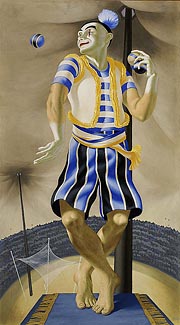 public as well as many art critics were never quite
clear about what the term actually meant. At the same time,
there is no doubt that a widespread current within figurative
painting occurred during the four decades that followed World War I, a
movement
that is distinguishable from Expressionism, Surrealism
and Social Realism. Magic Realism quietly developed from many
commonalities among artists that included an affinity for the traditions
of techniques, and a love of art history. Magic Realists also shared
a collective awareness of mankind's struggle to adapt to the many
insecurities of the modern world. Most of the major practitioners of
Magic Realism have now passed on, yet they have left us a
magnificent legacy.
public as well as many art critics were never quite
clear about what the term actually meant. At the same time,
there is no doubt that a widespread current within figurative
painting occurred during the four decades that followed World War I, a
movement
that is distinguishable from Expressionism, Surrealism
and Social Realism. Magic Realism quietly developed from many
commonalities among artists that included an affinity for the traditions
of techniques, and a love of art history. Magic Realists also shared
a collective awareness of mankind's struggle to adapt to the many
insecurities of the modern world. Most of the major practitioners of
Magic Realism have now passed on, yet they have left us a
magnificent legacy.
A list of the artists associated with Magic Realism follows below. This
list is not exhaustive. A great many paintings produced after World
War I exhibit the stylistic characteristics enumerated by Franz Roh
in his 1925 book. Although Roh addressed content in less specific
terms, his multifaceted groupings of Magic Realism's origins
provided a framework on which others built a movement. Important Magic Realists are followed by
two asterisks, with other significant artists followed by one
asterisk. Commentary about most of these painters has been provided
within
their
galleries. Annotations and references for this article are
available on request..
"They (Magic Realists) used a form of stylization whereby the
observed phenomenon was reduced to its essence, confirming the
oneness of the gestalt despite the multiplicity of its aspects.
Notwithstanding their avowed goal of capturing the appearance of
momentary phenomenon with the utmost fidelity, their unconscious aim
was to transcend the many contingent modes of reality and create an
eidos, an abstract essential form ; therefore their realism was
never quite "real", but rather a synthesis of their perceptions
expressed in the disciplined, methodical treatment of the painted
image: the experience of vision. This phenomenon is inseparably
associated with appearance as phantasia." Art Historian Edith
Balas, from The early works of Henry Koerner, 1945-1957.
Georg
Kremer - Email:
editor@monograffii.com
|
Images listed in
Descending Order (Click on Image for Enlargement) |
|
The Mountain
(1937) by Balthus |
|
Self Portrait as a
Clown (1921) by Max Beckmann |
|
Stilleben mit Krug
Pflanze und Spielkarten (1925) by Alexander Kanoldt |
|
Triglion (Imperial
Countess Triangi-Taglioni) (1926) by Christian Schad |
|
Die große
Hafenstadt - The Big Port (1928) by Herbert Reyl-Hanisch |
|
Ferruccio Ferrazzi,
Orizia agli specchi 1925 |
|
Selfportrait with
ophthalmological equipment (1928-30) by Herbert Ploberger |
|
Shooting Gallery
(1931) by Pyke Koch |
|
Arnold Comes of
Age (Portrait of Arnold Pyle) (1930) by Grant Wood |
|
Jukebox (1953) by
George Tooker |
|
Automation (1979)
by James Wyeth |
| |
|
Artists whom have connected to Magic
Realism |
|
| |
|
|
Notes:
1a) page 16 - Magic Realism Rediscovered, 1918-1981,
Seymour Menton, Art Alliance Press, London, c1983.
b)
page 18 - New Objectivity Neue Sachlichkeit - Painting in
Germany in the 1920s, Sergiusz Michalski, Taschen, 2003.
1c)
page 113 -
German Art in the 20th Century.
Franx Roh, Greenwich, Connecticut: New York Graphic Society, Ltd,
1958.
1d) page 57 - Magic Realism Rediscovered, 1918-1981,
Seymour Menton, Art Alliance Press, London, c1983.
1e)
page 24 - Magic Realism: Theory,
History, Community, edited by Lois Parkinson Zamora, Wendy B.
Faris, Duke University Press, 199
1f)
page 24 -
Magic Realism: Theory, History,
Community, edited by Lois Parkinson Zamora, Wendy B. Faris,
Duke University Press, 199
1g)
page 182 - Wonder and Exile in the New World, by Alex Nava, Penn
State University Press, 2013.
1h)
page 154
- German Post-Expressionism, Dennis Crockett,
The Pennsylvania State University Press, 1999
1i)
Introduction - The Unconcept, The Freudian Uncany in
Late-Twentieth-Century Theory, SUNY Press, 2011.
1j)
Frida Kahlo quoted in Time Magazine, "Mexican Autobiography"
(27 April 1953)
1k)
page 23 - Magic Realism Rediscovered, 1918-1981,
Seymour Menton, Art Alliance Press, London, c1983.
1l
American Realist and Magic Realist, Catalog, MOMA, New
York, Introduction by Lincoln Kirsten, 1943.
1m)
Page 24 - Reality Recurs as A Dream - George Tooker, D.C.
Moore Gallery 2011
Additional
References to be provided upon request.
Recommended Reading: |
|
Magic Realism Rediscovered, 1918-1981,
Seymour Menton, Art Alliance Press, London, c1983.
American Realism,
Edward Lucie-Smith , Thames & Hudson, 2002.
American Realist and
Magic Realist, Catalog, MOMA, New York, Introduction by
Lincoln Kirsten, 1943.
German Art in the 20th Century.
Franx Roh, Greenwich, Connecticut: New York Graphic Society, Ltd,
1958.
German Post-Expressionism, Dennis Crockett, The
Pennsylvania State University Press, 1999.
Illusions of Reality, Naturalist Paiunting, Photography and Cinema,
1875-1918, Gabriel P. Weisberg, Van Gogh Museum, Ateneum Art
Museum, Mercatorfonds, 2011
Magic
Realism: Defining the Indefinite, Jeffrey Weshsler, Art Journal,
Winter 1981.
Magic Realism: An
American Response to Surrealism (Exhibition Catalog /
June 12-September 6, 1999) - Southern Alleghenies
Museum of Art, Loretto, Pennsylvania.
Magic Realism: Theory,
History, Community, edited by Lois Parkinson Zamora,
Wendy B. Faris, Duke University Press, 1995.
New Objectivity Neue
Sachlichkeit - Painting in Germany in the 1920s, Sergiusz
Michalski, Taschen, 2003.
Realism and Realities. The Other Side of American Painting 1940-1960,
Greta Berman and Jeffrey Wechsler, New Brunswick Rutgers University,
1982.
Realism, Rationalism, Surrealism - Art between the Wars by
Briony Fer, David Batchelor and Paul Wood, Yale University Press
1993, ISBN 0-300-05518-8
Reality Recurs as A
Dream - George Tooker, D.C. Moore Gallery 2011
Surrealism and American Art 1931-1947,
Jeffrey Wechsler, Rutgers University Art Gallery, 1977 (exhibition
catalog)
The
Uncanny, Nicholas Royle, Routledge, Taylor & Francis Group, New
York, 2003.
The Unconcept, The
Freudian Uncany in Late-Twentieth-Century Theory, SUNY Press,
2011.
Copyright to
The Essense of Magic Realism
registered on January 1, 2015 with the United States Copyright
Office, a Department of the Library of Congress.

|
| |
|


 |